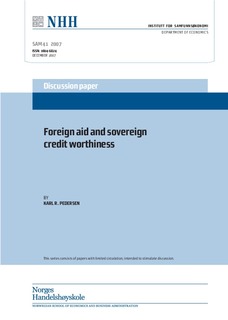| dc.contributor.author | Pedersen, Karl Rolf | |
| dc.date.accessioned | 2008-09-09T07:42:17Z | |
| dc.date.available | 2008-09-09T07:42:17Z | |
| dc.date.issued | 2007-12 | |
| dc.identifier.issn | 0804-6824 | |
| dc.identifier.uri | http://hdl.handle.net/11250/163124 | |
| dc.description.abstract | International financial markets are far from perfect. Because of problems related to contract enforcement borrowers often end up being rationed; the lenders tend to constrain the amount lent ex ante in
order to motivate the borrowers to fulfil their obligations and not default ex post. In this paper we take as
our point of departure a relationship like this between a lender (or consortium of lenders) and the government
of a poor country and ask: How is this relationship affected by the fact that the borrowing country also
receives foreign aid? The answer depends on how the aid is given. If the aid inflow
is exogenous we show
that some types of aid are effective in the sense that the aid has a positive effect on the credit obtained and
aggregate welfare. Other types are directly counterproductive. If the aid inflowow is endogenous, supplied by
altruistic donors as part of a safety-net, serious incentive distortions arise, crowding out private credit. Such
aid may actually be welfare-reducing in the recipient country. The paper also contains a discussion of how aid will influence lenders' incentives to give relief if the initial debt is not sustainable. | en |
| dc.language.iso | eng | en |
| dc.publisher | Norwegian School of Economics and Business Administration. Department of Economics | en |
| dc.relation.ispartofseries | Discussion paper | en |
| dc.relation.ispartofseries | 2007:41 | en |
| dc.subject | foreign aid | en |
| dc.subject | credit worthiness | en |
| dc.title | Foreign aid and sovereign credit worthiness | en |
| dc.type | Working paper | en |
| dc.subject.nsi | VDP::Samfunnsvitenskap: 200::Økonomi: 210::Samfunnsøkonomi: 212 | en |
